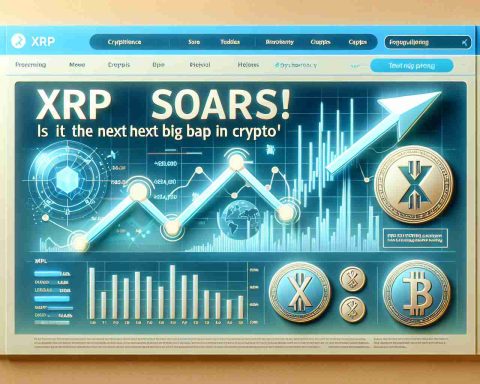Futures Contracts on the Horizon
The Chicago Mercantile Exchange (CME) is reportedly gearing up to launch futures contracts for Ripple’s XRP and Solana (SOL), spurring widespread speculation in the crypto community. A now-removed staging webpage hinted at the launches, indicating that trading could commence on February 10.
This unveiling, though quickly taken down, captured attention as it could signal a surge of new crypto ETF applications for these prominent cryptocurrencies. Observers have noted that such products will likely be available in various contract sizes, pending regulatory reviews.
Industry analysts have weighed in, indicating that if CME provides an official confirmation, it could catalyze a flurry of futures ETF applications for both XRP and Solana. This would also potentially influence the U.S. Securities and Exchange Commission (SEC) regarding blockchain asset regulation.
XRP is currently navigating a tight trading range while seeking to ascend beyond a significant descending resistance line. Despite recent market fluctuations, it has shown resilience, evident in its trading patterns.
As developments unfold, XRP investors are particularly keen on a movement beyond the $3.55 level. Meanwhile, analysts are closely monitoring crypto market trends, expecting the SEC’s upcoming decisions could reshape the landscape further. Stay tuned for updates as the scenario continues to evolve in this dynamic sector.
The Broader Implications of Crypto Futures Contracts
The initiation of futures contracts for Ripple’s XRP and Solana (SOL) at the Chicago Mercantile Exchange (CME) represents much more than a mere trading opportunity; it signals a profound shift in the regulatory and economic landscape of cryptocurrency. If confirmed, CME’s move could usher in an era where cryptocurrencies are treated with the same legitimacy as traditional financial instruments, fundamentally changing the way investors and institutions engage with digital assets.
This development has significant implications for society and culture. The proliferation of crypto futures could democratize access to investment opportunities, making it easier for everyday investors to participate in the burgeoning blockchain economy. This inclusivity could foster a more diverse financial ecosystem, driving greater public interest in digital currencies and blockchain technology.
On a global scale, the introduction of crypto futures contracts could have repercussions for international trade and finance. As digital currencies gain traction, they may challenge existing financial systems and redefine global economic paradigms. Furthermore, ESG (Environmental, Social, and Governance) concerns are likely to come into sharper focus as the popularity of energy-intensive cryptocurrencies like Bitcoin is juxtaposed with more sustainable options like Solana.
Looking towards the future, the long-term significance of this move cannot be overstated. The framework put in place for trading these futures will likely serve as a blueprint for other financial instruments within the crypto space, influencing regulatory approaches worldwide and shaping the trajectory of the global economy as digital currencies become increasingly prominent. As such, the potential fallout from these developments warrants close monitoring by not only investors and analysts but also policymakers and environmental advocates.
Get Ready for the Rise: Futures Contracts for XRP and Solana Could Change the Crypto Game!
Futures Contracts on the Horizon
The Chicago Mercantile Exchange (CME) is set to potentially launch futures contracts for Ripple’s XRP and Solana (SOL), stirring considerable excitement in the cryptocurrency sector. While a recently removed staging webpage hinted at a launch date of February 10, the implications of such an introduction are just as significant as the contracts themselves.
Potential Impact on the Crypto Market
Analysts suggest that the introduction of futures contracts could ignite a wave of new crypto exchange-traded fund (ETF) applications specifically targeting XRP and Solana. These products may feature a variety of contract sizes, depending on regulatory approvals.
The entry of CME into the XRP and Solana futures market could act as a catalyst for more comprehensive regulatory frameworks by the U.S. Securities and Exchange Commission (SEC) concerning blockchain assets. This is particularly important as many cryptocurrencies navigate the complexities of current regulations.
Key Features of the Expected Futures Contracts
– Diverse Contract Sizes: The futures may offer a range of sizes, accommodating various investor profiles.
– Regulatory Oversight: Approval from regulatory bodies will likely define the parameters within which these contracts operate.
– Market Volatility: Given the historical price volatility of XRP and SOL, futures could provide investors with hedging opportunities amidst fluctuating markets.
Market Sentiment and Price Movements
Currently, XRP is actively seeking to break past a formidable descending resistance line while trading within a tight range. Analysts have identified $3.55 as a critical resistance level, and a sustained movement beyond this mark could signal further gains, drawing more institutional interest.
Solana, on the other hand, has exhibited robust growth patterns and innovations that may enhance its adoption and usage, further bolstering market sentiment.
Pros and Cons of Futures Contracts
Pros:
– Hedging Against Price Fluctuations: Investors can protect themselves from adverse price movements.
– Increased Liquidity: The entry of futures may enhance market liquidity, driving participation from institutional investors.
Cons:
– Market Manipulation Risks: The nature of futures can sometimes lead to price manipulation.
– Complex Regulatory Environment: Navigating futures trading can be challenging due to varying regulations.
Looking Ahead: Predictions and Trends
As the crypto landscape evolves, the anticipated launch of futures contracts on the CME could significantly impact market behavior. Analysts predict an increase in investment interest and trading volume as more institutional players enter the market.
Furthermore, the SEC’s future decisions regarding blockchain assets will likely set precedents that could either facilitate or hinder the growth of cryptocurrency market instruments like ETFs and futures.
Conclusion
The speculation surrounding the CME’s potential launch of XRP and Solana futures contracts reflects the ongoing evolution of the cryptocurrency market and its growing connection with traditional financial systems. As always, investors are encouraged to stay informed and consider the inherent risks involved.
For more insights into the ever-changing world of cryptocurrency, visit the CME Group.













